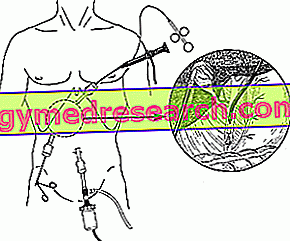cholangiography
If the ultrasound examination is positive, no further investigations are required to confirm the presence of gallbladder stones. If, on the other hand, the ultrasound is negative, further investigations may be carried out:
- Endoscopic Retrograde Cholangiography (ERCP): allows radiological evidence of the biliary and pancreatic tract health (common bile duct, gallbladder, common hepatic duct, intrahepatic ducts and pancreatic ductal system see: gallbladder anatomy). The contrast medium is injected through a tube inserted orally and sent down along the digestive tract to perform radiograms. Through other catheters it is also possible to perform therapeutic maneuvers such as the extraction of the stones or the drainage of the bile in the case of obstructive jaundice (benign or malignant).
- Percutaneous cholangioscopy (CPT): through a small hole made in the skin of the abdominal wall, a catheter is inserted that reaches the biliary tract directly and injects a radiological contrast agent. Obviously due to this incision percutena cholangioscopy is a fairly invasive test that is used only if the previous technique (ERCP) is contraindicated. Precisely for this reason percutaneous cholangioscopy should be performed in specialized centers that can intervene by removing the stones present in the biliary tract.
- MRI-Cholangiography : is an innovative technique that exploits the potential of nuclear magnetic resonance (NMR). It allows the computerized reconstruction of the intrahepatic bile ducts, allows the visualization of stenosis and lithiasis and is free of side effects. The only flaw lies in the difficult interpretation of the images and the impossibility of removing any obstacles to the flow of bile (calculations).
A normal direct radiograph of the abdomen is able to visualize only the radiopaque calculi (it is able to visualize the pigmentary stones but not those rich in cholesterol quite well).
Care and Treatment
Read also: Remedies for gallstones
If "liver" stones are occasionally discovered and there are no symptoms, the best thing to do is not to worry. The probability of developing a biliary colic in the following year is in fact very low (in the order of 2-3%). The risk of tumor formation in a gallbladder affected by stones does exist but is very low overall, so there is no need to worry too much about this.
If the gall bladder stones have already caused biliary colic, the probability that this colic will recur is rather high (around 60% over the following two years). For this reason, after a colic or other complications, the main indication is to intervene surgically by removing the gallbladder ( cholecystectomy ).
Cholecystectomy
In recent years, recourse to this intervention has become increasingly preventive in nature, especially if the calculations are small and multiple. The risk of these pebbles moving causing the typical complications of lithiasis (presence of stones in the cisitifellea), even if quite low, exists; consequently, a prophylactic approach to the disease is certainly preferable to urgent surgery.

Pharmacological alternatives
Cholecystectomy surgery is the only possibility to definitively resolve the problem. In fact, there are several medical therapies capable of destroying cholesterol stones with drugs similar to bile salts, but generally they require very long times, and above all they do not prevent the recurrence of gallstones at the gall bladder.
To learn more: Drugs for the treatment of gall bladder stones
How to do it
Thanks to the introduction of video surgery, known as the "minimally invasive" technique, the treatment of gallbladder stones has undergone considerable modernization in recent years. Through the small incisions made in the patient's abdomen, special instruments are inserted which will be manipulated by the surgeon with the help of images from a micro-camera introduced at the umbilical level. The introduction of gas into the abdominal cavity helps to lift the abdomen wall making operations easier.
Thanks to this type of operation, the post-operative course is faster and the patient can be discharged after 1-3 days after surgery, without the pains and difficulties of recovery characteristic of the past.
In general, after the gallbladder has been removed, life returns normally. In the postoperative phase a tendency to diarrhea may occur, but the body quickly adapts and these problems disappear.
To learn more, read the article on Cholecystectomy



